Customer Experience Management Planning: Thornbury Castle Hotel Report
VerifiedAdded on 2020/10/04
|15
|4328
|197
Report
AI Summary
This report delves into the critical aspects of customer experience management within the hospitality sector, using the Thornbury Castle Hotel as a case study. It begins by emphasizing the value of understanding customer needs, wants, and preferences, particularly for target markets like youngsters, couples, business travelers, and families. The report then explores the factors influencing customer engagement, including tourist experiences and tourism activities, and examines various on-boarding strategies. A significant portion is dedicated to the creation of a customer experience map, detailing the customer journey from discovery and booking to arrival, room allocation, dining, and checkout, highlighting key touchpoints and opportunities for optimization. The report also touches upon the role of digital technology in managing customer experience and concludes by outlining effective customer service strategies aimed at meeting and exceeding customer expectations, thereby fostering brand loyalty and achieving a competitive advantage in the market.
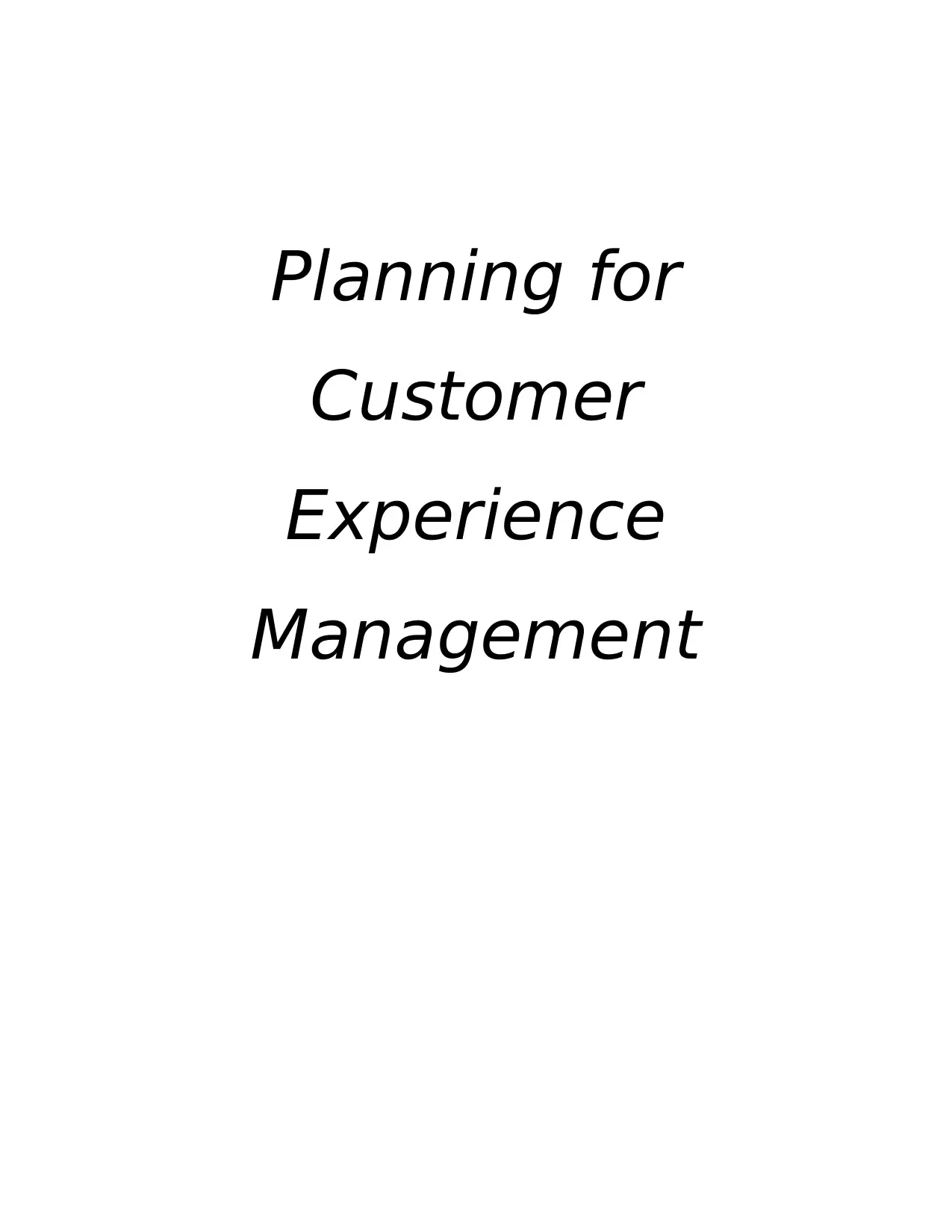
Planning for
Customer
Experience
Management
Customer
Experience
Management
Paraphrase This Document
Need a fresh take? Get an instant paraphrase of this document with our AI Paraphraser
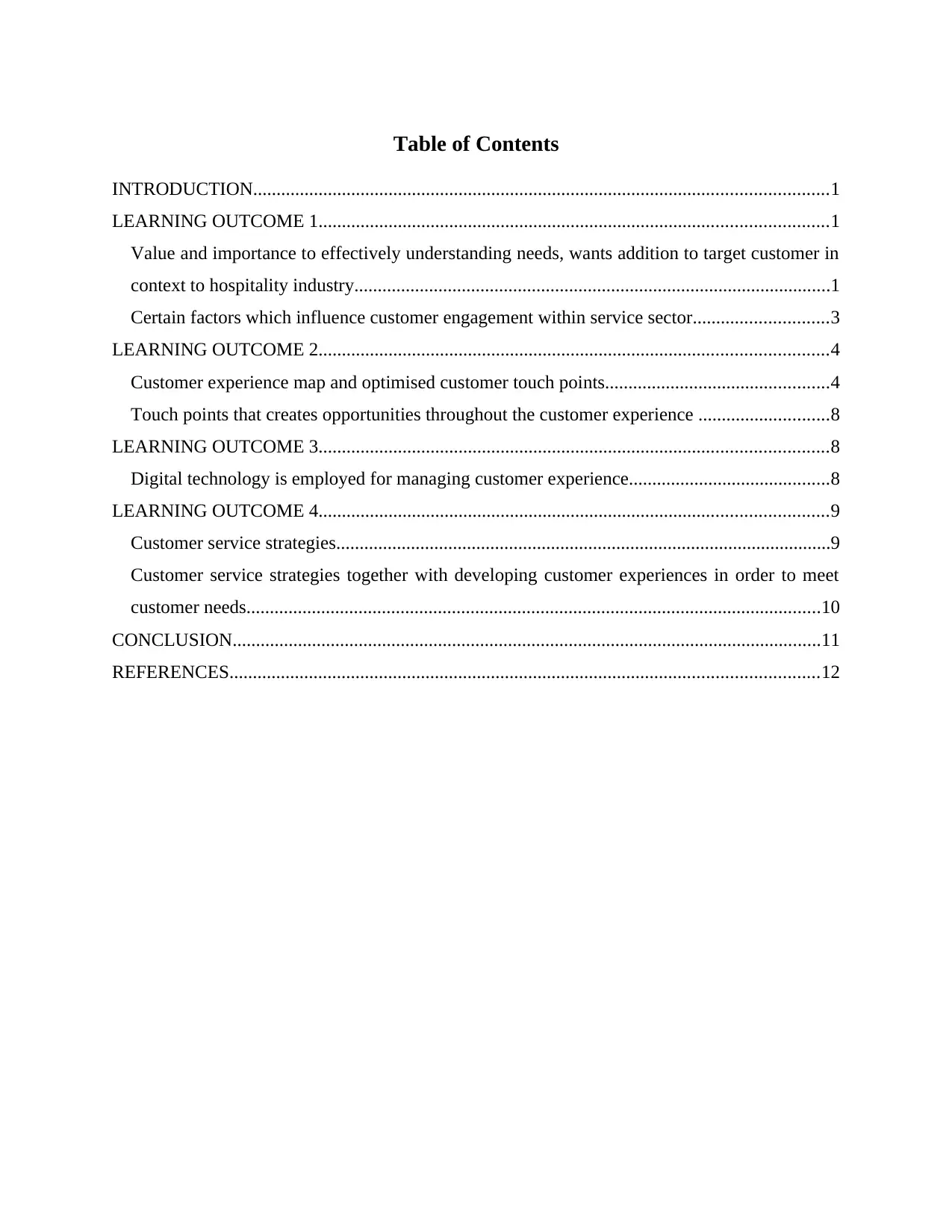
Table of Contents
INTRODUCTION...........................................................................................................................1
LEARNING OUTCOME 1.............................................................................................................1
Value and importance to effectively understanding needs, wants addition to target customer in
context to hospitality industry......................................................................................................1
Certain factors which influence customer engagement within service sector.............................3
LEARNING OUTCOME 2.............................................................................................................4
Customer experience map and optimised customer touch points................................................4
Touch points that creates opportunities throughout the customer experience ............................8
LEARNING OUTCOME 3.............................................................................................................8
Digital technology is employed for managing customer experience...........................................8
LEARNING OUTCOME 4.............................................................................................................9
Customer service strategies..........................................................................................................9
Customer service strategies together with developing customer experiences in order to meet
customer needs...........................................................................................................................10
CONCLUSION..............................................................................................................................11
REFERENCES..............................................................................................................................12
INTRODUCTION...........................................................................................................................1
LEARNING OUTCOME 1.............................................................................................................1
Value and importance to effectively understanding needs, wants addition to target customer in
context to hospitality industry......................................................................................................1
Certain factors which influence customer engagement within service sector.............................3
LEARNING OUTCOME 2.............................................................................................................4
Customer experience map and optimised customer touch points................................................4
Touch points that creates opportunities throughout the customer experience ............................8
LEARNING OUTCOME 3.............................................................................................................8
Digital technology is employed for managing customer experience...........................................8
LEARNING OUTCOME 4.............................................................................................................9
Customer service strategies..........................................................................................................9
Customer service strategies together with developing customer experiences in order to meet
customer needs...........................................................................................................................10
CONCLUSION..............................................................................................................................11
REFERENCES..............................................................................................................................12

⊘ This is a preview!⊘
Do you want full access?
Subscribe today to unlock all pages.

Trusted by 1+ million students worldwide
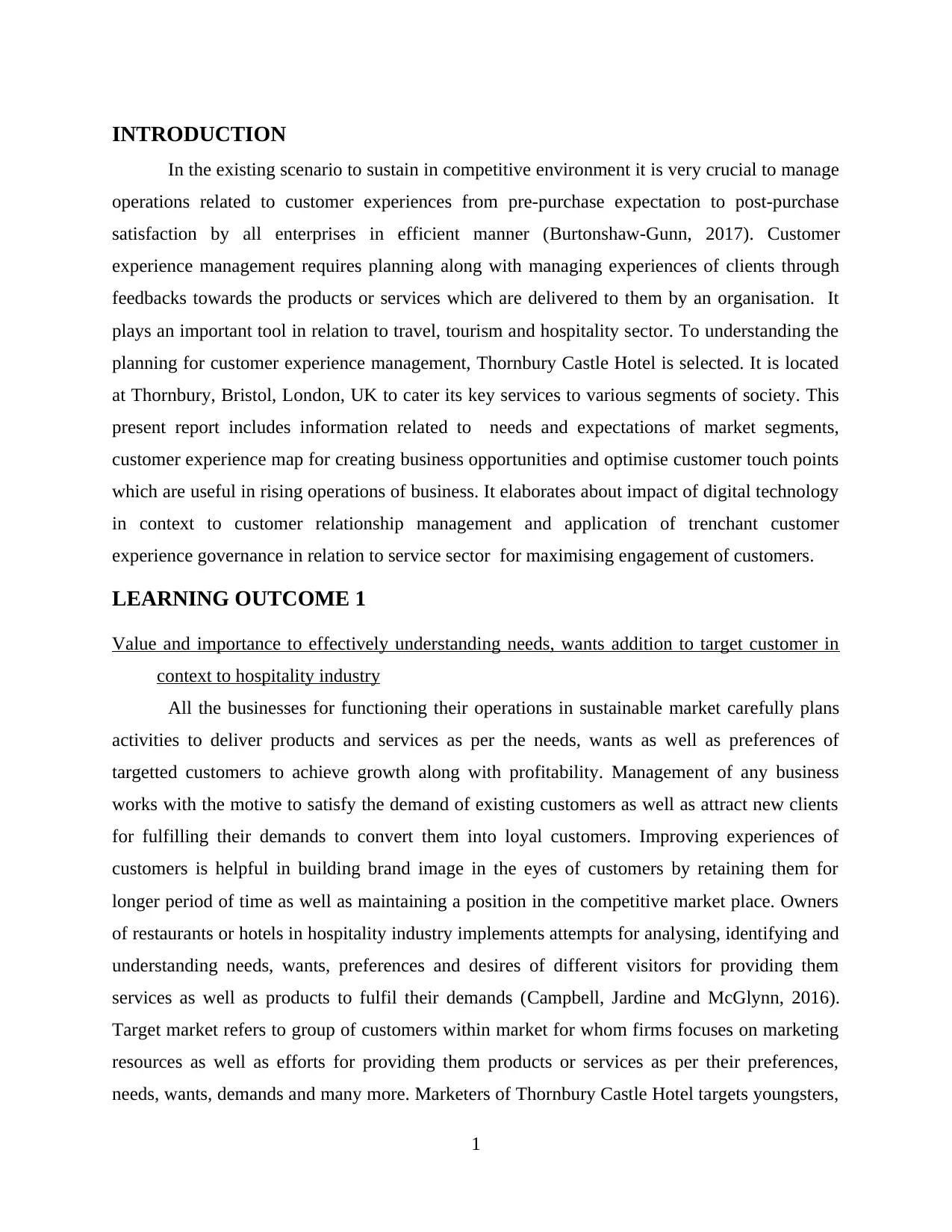
INTRODUCTION
In the existing scenario to sustain in competitive environment it is very crucial to manage
operations related to customer experiences from pre-purchase expectation to post-purchase
satisfaction by all enterprises in efficient manner (Burtonshaw-Gunn, 2017). Customer
experience management requires planning along with managing experiences of clients through
feedbacks towards the products or services which are delivered to them by an organisation. It
plays an important tool in relation to travel, tourism and hospitality sector. To understanding the
planning for customer experience management, Thornbury Castle Hotel is selected. It is located
at Thornbury, Bristol, London, UK to cater its key services to various segments of society. This
present report includes information related to needs and expectations of market segments,
customer experience map for creating business opportunities and optimise customer touch points
which are useful in rising operations of business. It elaborates about impact of digital technology
in context to customer relationship management and application of trenchant customer
experience governance in relation to service sector for maximising engagement of customers.
LEARNING OUTCOME 1
Value and importance to effectively understanding needs, wants addition to target customer in
context to hospitality industry
All the businesses for functioning their operations in sustainable market carefully plans
activities to deliver products and services as per the needs, wants as well as preferences of
targetted customers to achieve growth along with profitability. Management of any business
works with the motive to satisfy the demand of existing customers as well as attract new clients
for fulfilling their demands to convert them into loyal customers. Improving experiences of
customers is helpful in building brand image in the eyes of customers by retaining them for
longer period of time as well as maintaining a position in the competitive market place. Owners
of restaurants or hotels in hospitality industry implements attempts for analysing, identifying and
understanding needs, wants, preferences and desires of different visitors for providing them
services as well as products to fulfil their demands (Campbell, Jardine and McGlynn, 2016).
Target market refers to group of customers within market for whom firms focuses on marketing
resources as well as efforts for providing them products or services as per their preferences,
needs, wants, demands and many more. Marketers of Thornbury Castle Hotel targets youngsters,
1
In the existing scenario to sustain in competitive environment it is very crucial to manage
operations related to customer experiences from pre-purchase expectation to post-purchase
satisfaction by all enterprises in efficient manner (Burtonshaw-Gunn, 2017). Customer
experience management requires planning along with managing experiences of clients through
feedbacks towards the products or services which are delivered to them by an organisation. It
plays an important tool in relation to travel, tourism and hospitality sector. To understanding the
planning for customer experience management, Thornbury Castle Hotel is selected. It is located
at Thornbury, Bristol, London, UK to cater its key services to various segments of society. This
present report includes information related to needs and expectations of market segments,
customer experience map for creating business opportunities and optimise customer touch points
which are useful in rising operations of business. It elaborates about impact of digital technology
in context to customer relationship management and application of trenchant customer
experience governance in relation to service sector for maximising engagement of customers.
LEARNING OUTCOME 1
Value and importance to effectively understanding needs, wants addition to target customer in
context to hospitality industry
All the businesses for functioning their operations in sustainable market carefully plans
activities to deliver products and services as per the needs, wants as well as preferences of
targetted customers to achieve growth along with profitability. Management of any business
works with the motive to satisfy the demand of existing customers as well as attract new clients
for fulfilling their demands to convert them into loyal customers. Improving experiences of
customers is helpful in building brand image in the eyes of customers by retaining them for
longer period of time as well as maintaining a position in the competitive market place. Owners
of restaurants or hotels in hospitality industry implements attempts for analysing, identifying and
understanding needs, wants, preferences and desires of different visitors for providing them
services as well as products to fulfil their demands (Campbell, Jardine and McGlynn, 2016).
Target market refers to group of customers within market for whom firms focuses on marketing
resources as well as efforts for providing them products or services as per their preferences,
needs, wants, demands and many more. Marketers of Thornbury Castle Hotel targets youngsters,
1
Paraphrase This Document
Need a fresh take? Get an instant paraphrase of this document with our AI Paraphraser
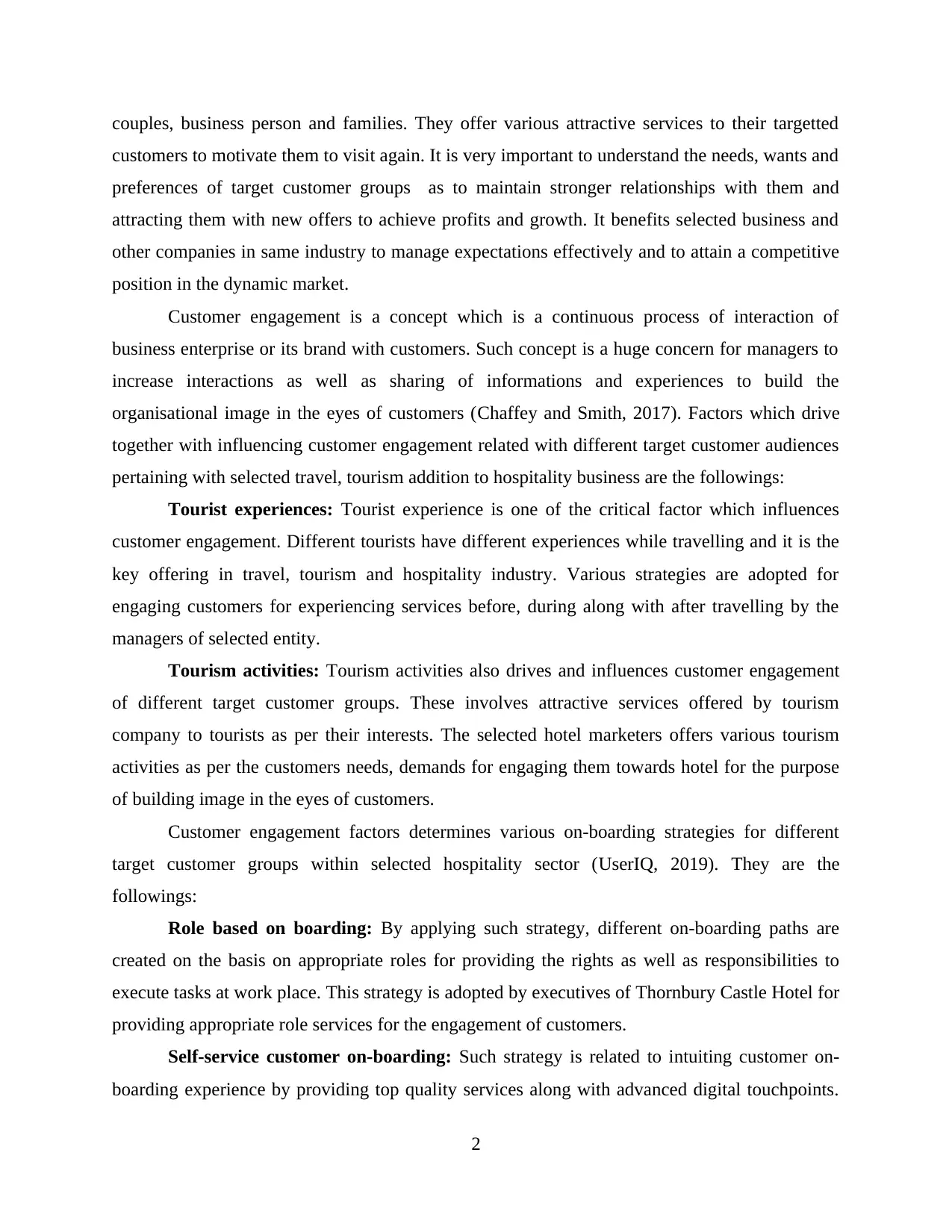
couples, business person and families. They offer various attractive services to their targetted
customers to motivate them to visit again. It is very important to understand the needs, wants and
preferences of target customer groups as to maintain stronger relationships with them and
attracting them with new offers to achieve profits and growth. It benefits selected business and
other companies in same industry to manage expectations effectively and to attain a competitive
position in the dynamic market.
Customer engagement is a concept which is a continuous process of interaction of
business enterprise or its brand with customers. Such concept is a huge concern for managers to
increase interactions as well as sharing of informations and experiences to build the
organisational image in the eyes of customers (Chaffey and Smith, 2017). Factors which drive
together with influencing customer engagement related with different target customer audiences
pertaining with selected travel, tourism addition to hospitality business are the followings:
Tourist experiences: Tourist experience is one of the critical factor which influences
customer engagement. Different tourists have different experiences while travelling and it is the
key offering in travel, tourism and hospitality industry. Various strategies are adopted for
engaging customers for experiencing services before, during along with after travelling by the
managers of selected entity.
Tourism activities: Tourism activities also drives and influences customer engagement
of different target customer groups. These involves attractive services offered by tourism
company to tourists as per their interests. The selected hotel marketers offers various tourism
activities as per the customers needs, demands for engaging them towards hotel for the purpose
of building image in the eyes of customers.
Customer engagement factors determines various on-boarding strategies for different
target customer groups within selected hospitality sector (UserIQ, 2019). They are the
followings:
Role based on boarding: By applying such strategy, different on-boarding paths are
created on the basis on appropriate roles for providing the rights as well as responsibilities to
execute tasks at work place. This strategy is adopted by executives of Thornbury Castle Hotel for
providing appropriate role services for the engagement of customers.
Self-service customer on-boarding: Such strategy is related to intuiting customer on-
boarding experience by providing top quality services along with advanced digital touchpoints.
2
customers to motivate them to visit again. It is very important to understand the needs, wants and
preferences of target customer groups as to maintain stronger relationships with them and
attracting them with new offers to achieve profits and growth. It benefits selected business and
other companies in same industry to manage expectations effectively and to attain a competitive
position in the dynamic market.
Customer engagement is a concept which is a continuous process of interaction of
business enterprise or its brand with customers. Such concept is a huge concern for managers to
increase interactions as well as sharing of informations and experiences to build the
organisational image in the eyes of customers (Chaffey and Smith, 2017). Factors which drive
together with influencing customer engagement related with different target customer audiences
pertaining with selected travel, tourism addition to hospitality business are the followings:
Tourist experiences: Tourist experience is one of the critical factor which influences
customer engagement. Different tourists have different experiences while travelling and it is the
key offering in travel, tourism and hospitality industry. Various strategies are adopted for
engaging customers for experiencing services before, during along with after travelling by the
managers of selected entity.
Tourism activities: Tourism activities also drives and influences customer engagement
of different target customer groups. These involves attractive services offered by tourism
company to tourists as per their interests. The selected hotel marketers offers various tourism
activities as per the customers needs, demands for engaging them towards hotel for the purpose
of building image in the eyes of customers.
Customer engagement factors determines various on-boarding strategies for different
target customer groups within selected hospitality sector (UserIQ, 2019). They are the
followings:
Role based on boarding: By applying such strategy, different on-boarding paths are
created on the basis on appropriate roles for providing the rights as well as responsibilities to
execute tasks at work place. This strategy is adopted by executives of Thornbury Castle Hotel for
providing appropriate role services for the engagement of customers.
Self-service customer on-boarding: Such strategy is related to intuiting customer on-
boarding experience by providing top quality services along with advanced digital touchpoints.
2
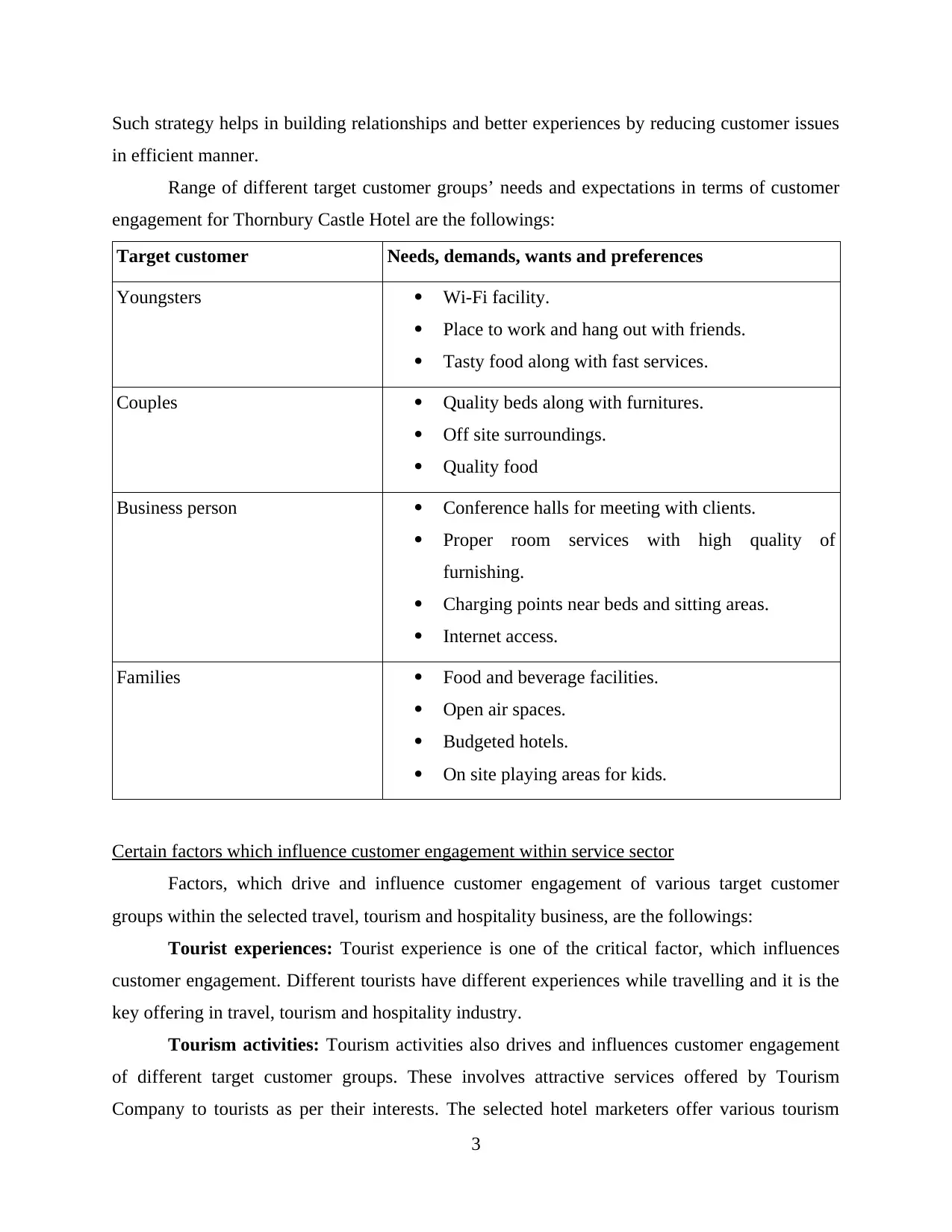
Such strategy helps in building relationships and better experiences by reducing customer issues
in efficient manner.
Range of different target customer groups’ needs and expectations in terms of customer
engagement for Thornbury Castle Hotel are the followings:
Target customer Needs, demands, wants and preferences
Youngsters Wi-Fi facility.
Place to work and hang out with friends.
Tasty food along with fast services.
Couples Quality beds along with furnitures.
Off site surroundings.
Quality food
Business person Conference halls for meeting with clients.
Proper room services with high quality of
furnishing.
Charging points near beds and sitting areas.
Internet access.
Families Food and beverage facilities.
Open air spaces.
Budgeted hotels.
On site playing areas for kids.
Certain factors which influence customer engagement within service sector
Factors, which drive and influence customer engagement of various target customer
groups within the selected travel, tourism and hospitality business, are the followings:
Tourist experiences: Tourist experience is one of the critical factor, which influences
customer engagement. Different tourists have different experiences while travelling and it is the
key offering in travel, tourism and hospitality industry.
Tourism activities: Tourism activities also drives and influences customer engagement
of different target customer groups. These involves attractive services offered by Tourism
Company to tourists as per their interests. The selected hotel marketers offer various tourism
3
in efficient manner.
Range of different target customer groups’ needs and expectations in terms of customer
engagement for Thornbury Castle Hotel are the followings:
Target customer Needs, demands, wants and preferences
Youngsters Wi-Fi facility.
Place to work and hang out with friends.
Tasty food along with fast services.
Couples Quality beds along with furnitures.
Off site surroundings.
Quality food
Business person Conference halls for meeting with clients.
Proper room services with high quality of
furnishing.
Charging points near beds and sitting areas.
Internet access.
Families Food and beverage facilities.
Open air spaces.
Budgeted hotels.
On site playing areas for kids.
Certain factors which influence customer engagement within service sector
Factors, which drive and influence customer engagement of various target customer
groups within the selected travel, tourism and hospitality business, are the followings:
Tourist experiences: Tourist experience is one of the critical factor, which influences
customer engagement. Different tourists have different experiences while travelling and it is the
key offering in travel, tourism and hospitality industry.
Tourism activities: Tourism activities also drives and influences customer engagement
of different target customer groups. These involves attractive services offered by Tourism
Company to tourists as per their interests. The selected hotel marketers offer various tourism
3
⊘ This is a preview!⊘
Do you want full access?
Subscribe today to unlock all pages.

Trusted by 1+ million students worldwide
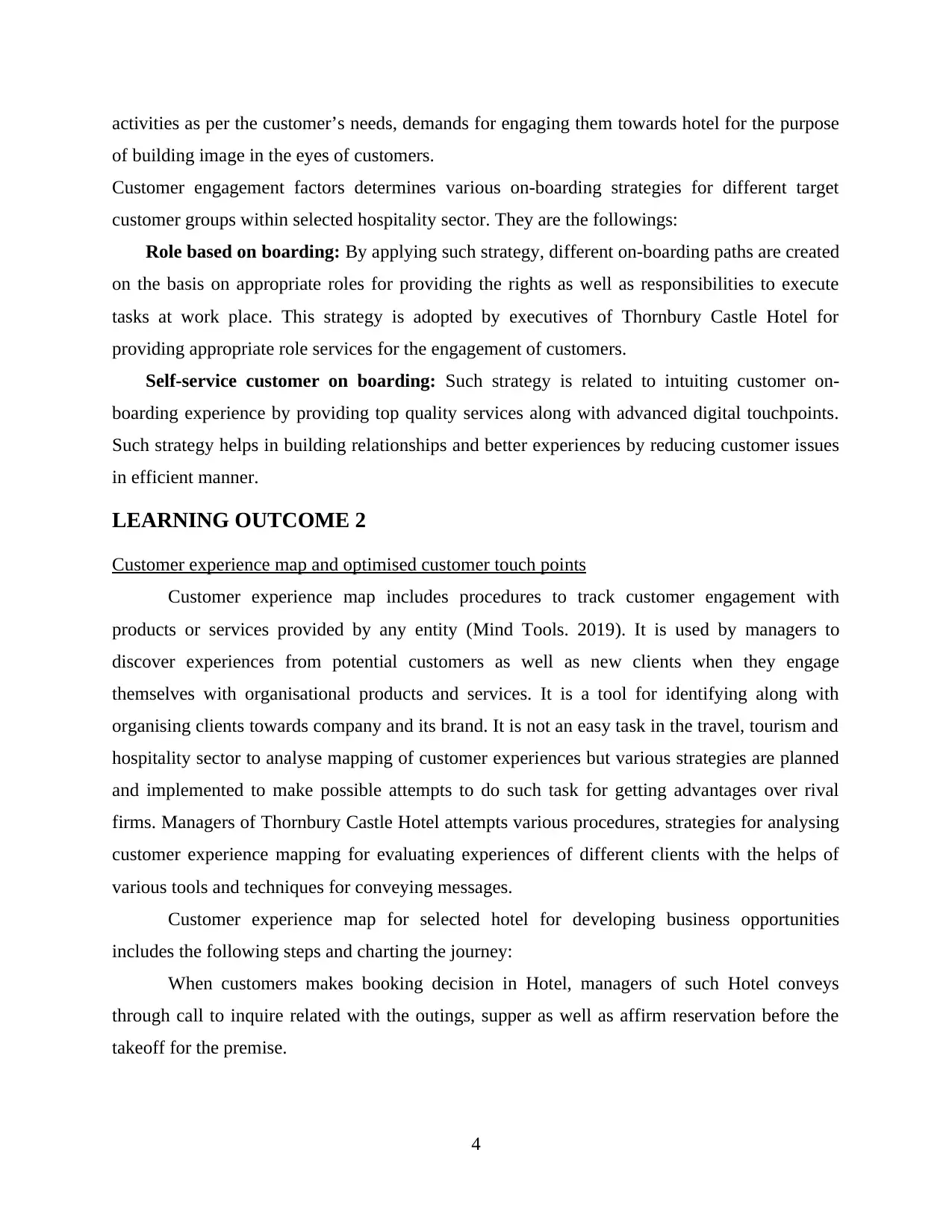
activities as per the customer’s needs, demands for engaging them towards hotel for the purpose
of building image in the eyes of customers.
Customer engagement factors determines various on-boarding strategies for different target
customer groups within selected hospitality sector. They are the followings:
Role based on boarding: By applying such strategy, different on-boarding paths are created
on the basis on appropriate roles for providing the rights as well as responsibilities to execute
tasks at work place. This strategy is adopted by executives of Thornbury Castle Hotel for
providing appropriate role services for the engagement of customers.
Self-service customer on boarding: Such strategy is related to intuiting customer on-
boarding experience by providing top quality services along with advanced digital touchpoints.
Such strategy helps in building relationships and better experiences by reducing customer issues
in efficient manner.
LEARNING OUTCOME 2
Customer experience map and optimised customer touch points
Customer experience map includes procedures to track customer engagement with
products or services provided by any entity (Mind Tools. 2019). It is used by managers to
discover experiences from potential customers as well as new clients when they engage
themselves with organisational products and services. It is a tool for identifying along with
organising clients towards company and its brand. It is not an easy task in the travel, tourism and
hospitality sector to analyse mapping of customer experiences but various strategies are planned
and implemented to make possible attempts to do such task for getting advantages over rival
firms. Managers of Thornbury Castle Hotel attempts various procedures, strategies for analysing
customer experience mapping for evaluating experiences of different clients with the helps of
various tools and techniques for conveying messages.
Customer experience map for selected hotel for developing business opportunities
includes the following steps and charting the journey:
When customers makes booking decision in Hotel, managers of such Hotel conveys
through call to inquire related with the outings, supper as well as affirm reservation before the
takeoff for the premise.
4
of building image in the eyes of customers.
Customer engagement factors determines various on-boarding strategies for different target
customer groups within selected hospitality sector. They are the followings:
Role based on boarding: By applying such strategy, different on-boarding paths are created
on the basis on appropriate roles for providing the rights as well as responsibilities to execute
tasks at work place. This strategy is adopted by executives of Thornbury Castle Hotel for
providing appropriate role services for the engagement of customers.
Self-service customer on boarding: Such strategy is related to intuiting customer on-
boarding experience by providing top quality services along with advanced digital touchpoints.
Such strategy helps in building relationships and better experiences by reducing customer issues
in efficient manner.
LEARNING OUTCOME 2
Customer experience map and optimised customer touch points
Customer experience map includes procedures to track customer engagement with
products or services provided by any entity (Mind Tools. 2019). It is used by managers to
discover experiences from potential customers as well as new clients when they engage
themselves with organisational products and services. It is a tool for identifying along with
organising clients towards company and its brand. It is not an easy task in the travel, tourism and
hospitality sector to analyse mapping of customer experiences but various strategies are planned
and implemented to make possible attempts to do such task for getting advantages over rival
firms. Managers of Thornbury Castle Hotel attempts various procedures, strategies for analysing
customer experience mapping for evaluating experiences of different clients with the helps of
various tools and techniques for conveying messages.
Customer experience map for selected hotel for developing business opportunities
includes the following steps and charting the journey:
When customers makes booking decision in Hotel, managers of such Hotel conveys
through call to inquire related with the outings, supper as well as affirm reservation before the
takeoff for the premise.
4
Paraphrase This Document
Need a fresh take? Get an instant paraphrase of this document with our AI Paraphraser
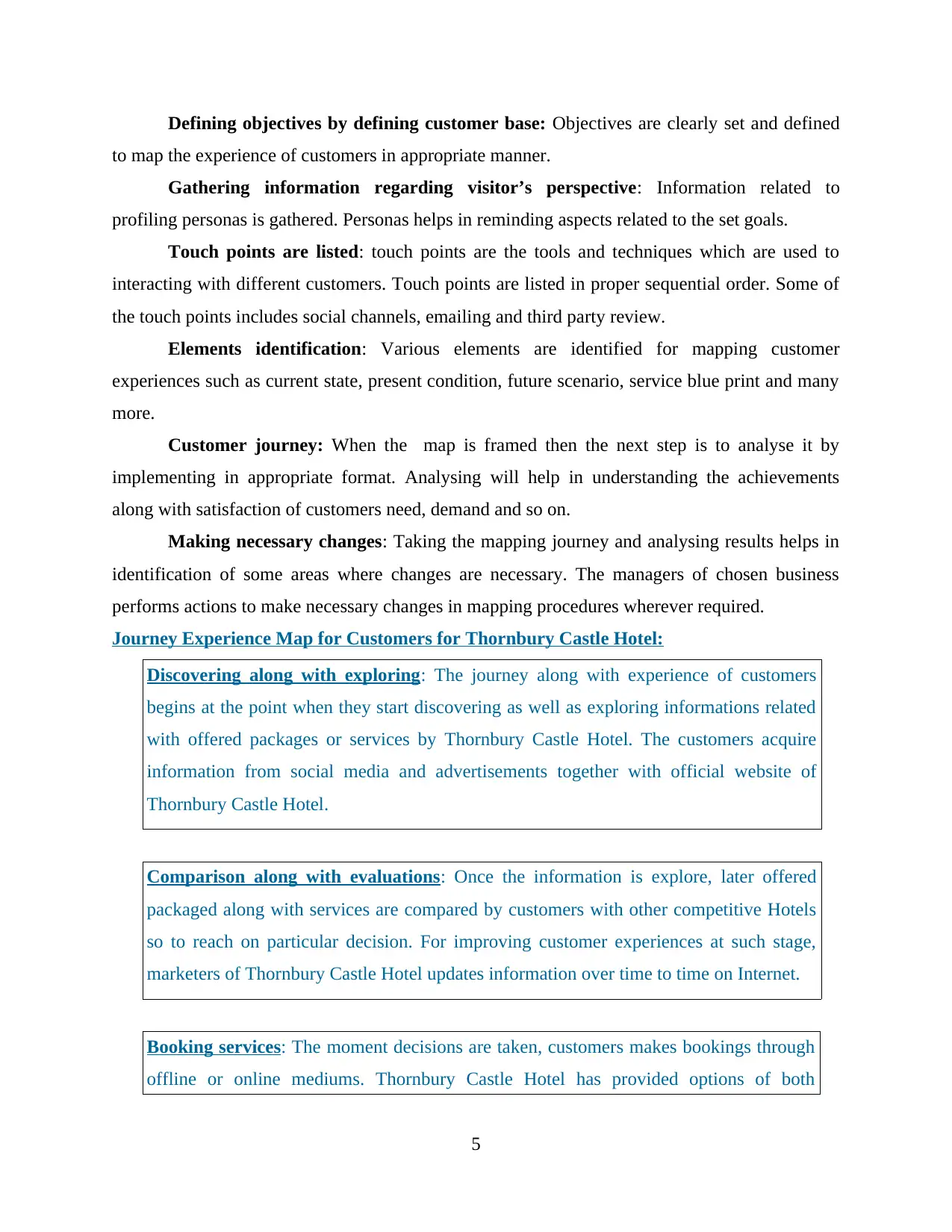
Defining objectives by defining customer base: Objectives are clearly set and defined
to map the experience of customers in appropriate manner.
Gathering information regarding visitor’s perspective: Information related to
profiling personas is gathered. Personas helps in reminding aspects related to the set goals.
Touch points are listed: touch points are the tools and techniques which are used to
interacting with different customers. Touch points are listed in proper sequential order. Some of
the touch points includes social channels, emailing and third party review.
Elements identification: Various elements are identified for mapping customer
experiences such as current state, present condition, future scenario, service blue print and many
more.
Customer journey: When the map is framed then the next step is to analyse it by
implementing in appropriate format. Analysing will help in understanding the achievements
along with satisfaction of customers need, demand and so on.
Making necessary changes: Taking the mapping journey and analysing results helps in
identification of some areas where changes are necessary. The managers of chosen business
performs actions to make necessary changes in mapping procedures wherever required.
Journey Experience Map for Customers for Thornbury Castle Hotel:
Discovering along with exploring: The journey along with experience of customers
begins at the point when they start discovering as well as exploring informations related
with offered packages or services by Thornbury Castle Hotel. The customers acquire
information from social media and advertisements together with official website of
Thornbury Castle Hotel.
Comparison along with evaluations: Once the information is explore, later offered
packaged along with services are compared by customers with other competitive Hotels
so to reach on particular decision. For improving customer experiences at such stage,
marketers of Thornbury Castle Hotel updates information over time to time on Internet.
Booking services: The moment decisions are taken, customers makes bookings through
offline or online mediums. Thornbury Castle Hotel has provided options of both
5
to map the experience of customers in appropriate manner.
Gathering information regarding visitor’s perspective: Information related to
profiling personas is gathered. Personas helps in reminding aspects related to the set goals.
Touch points are listed: touch points are the tools and techniques which are used to
interacting with different customers. Touch points are listed in proper sequential order. Some of
the touch points includes social channels, emailing and third party review.
Elements identification: Various elements are identified for mapping customer
experiences such as current state, present condition, future scenario, service blue print and many
more.
Customer journey: When the map is framed then the next step is to analyse it by
implementing in appropriate format. Analysing will help in understanding the achievements
along with satisfaction of customers need, demand and so on.
Making necessary changes: Taking the mapping journey and analysing results helps in
identification of some areas where changes are necessary. The managers of chosen business
performs actions to make necessary changes in mapping procedures wherever required.
Journey Experience Map for Customers for Thornbury Castle Hotel:
Discovering along with exploring: The journey along with experience of customers
begins at the point when they start discovering as well as exploring informations related
with offered packages or services by Thornbury Castle Hotel. The customers acquire
information from social media and advertisements together with official website of
Thornbury Castle Hotel.
Comparison along with evaluations: Once the information is explore, later offered
packaged along with services are compared by customers with other competitive Hotels
so to reach on particular decision. For improving customer experiences at such stage,
marketers of Thornbury Castle Hotel updates information over time to time on Internet.
Booking services: The moment decisions are taken, customers makes bookings through
offline or online mediums. Thornbury Castle Hotel has provided options of both
5
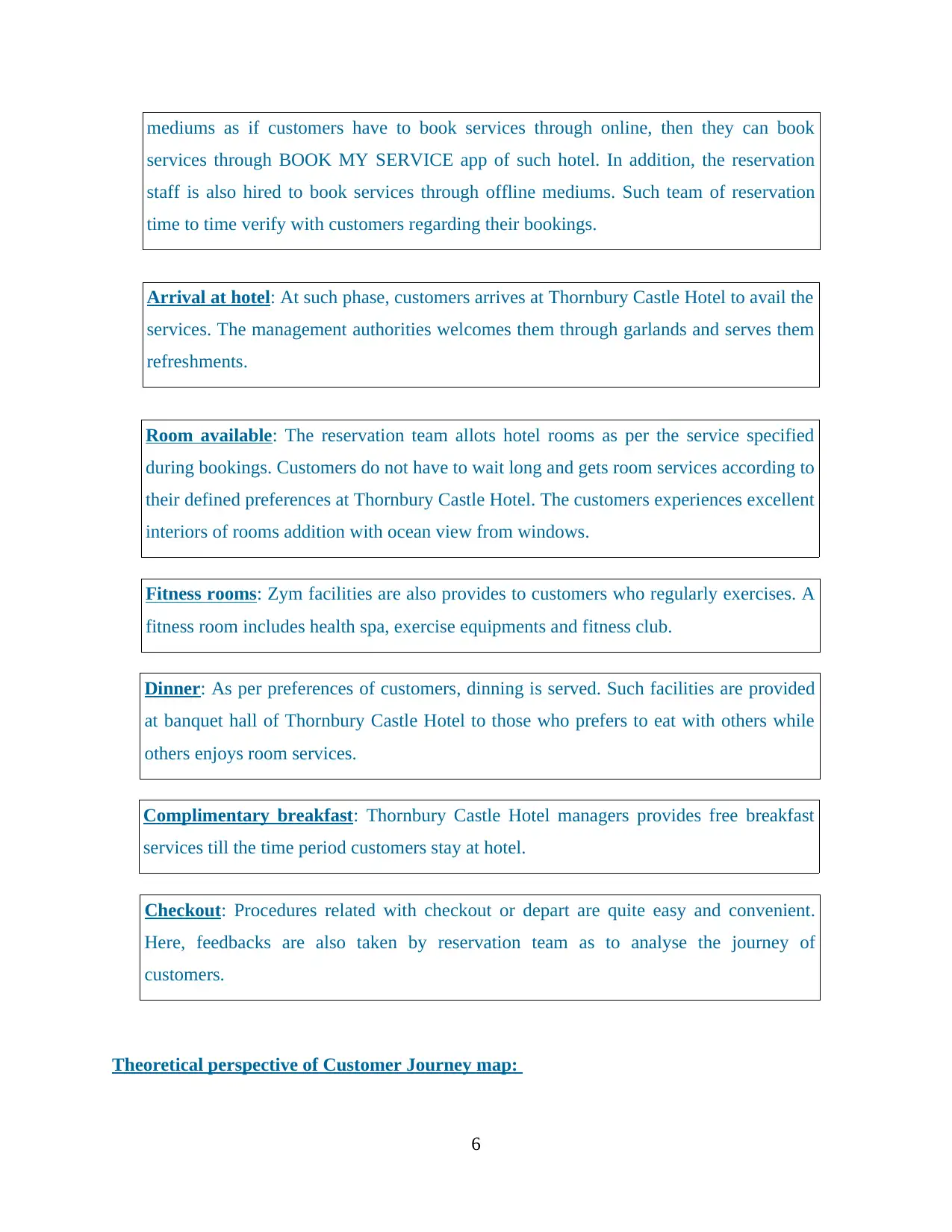
mediums as if customers have to book services through online, then they can book
services through BOOK MY SERVICE app of such hotel. In addition, the reservation
staff is also hired to book services through offline mediums. Such team of reservation
time to time verify with customers regarding their bookings.
Arrival at hotel: At such phase, customers arrives at Thornbury Castle Hotel to avail the
services. The management authorities welcomes them through garlands and serves them
refreshments.
Room available: The reservation team allots hotel rooms as per the service specified
during bookings. Customers do not have to wait long and gets room services according to
their defined preferences at Thornbury Castle Hotel. The customers experiences excellent
interiors of rooms addition with ocean view from windows.
Fitness rooms: Zym facilities are also provides to customers who regularly exercises. A
fitness room includes health spa, exercise equipments and fitness club.
Dinner: As per preferences of customers, dinning is served. Such facilities are provided
at banquet hall of Thornbury Castle Hotel to those who prefers to eat with others while
others enjoys room services.
Complimentary breakfast: Thornbury Castle Hotel managers provides free breakfast
services till the time period customers stay at hotel.
Checkout: Procedures related with checkout or depart are quite easy and convenient.
Here, feedbacks are also taken by reservation team as to analyse the journey of
customers.
Theoretical perspective of Customer Journey map:
6
services through BOOK MY SERVICE app of such hotel. In addition, the reservation
staff is also hired to book services through offline mediums. Such team of reservation
time to time verify with customers regarding their bookings.
Arrival at hotel: At such phase, customers arrives at Thornbury Castle Hotel to avail the
services. The management authorities welcomes them through garlands and serves them
refreshments.
Room available: The reservation team allots hotel rooms as per the service specified
during bookings. Customers do not have to wait long and gets room services according to
their defined preferences at Thornbury Castle Hotel. The customers experiences excellent
interiors of rooms addition with ocean view from windows.
Fitness rooms: Zym facilities are also provides to customers who regularly exercises. A
fitness room includes health spa, exercise equipments and fitness club.
Dinner: As per preferences of customers, dinning is served. Such facilities are provided
at banquet hall of Thornbury Castle Hotel to those who prefers to eat with others while
others enjoys room services.
Complimentary breakfast: Thornbury Castle Hotel managers provides free breakfast
services till the time period customers stay at hotel.
Checkout: Procedures related with checkout or depart are quite easy and convenient.
Here, feedbacks are also taken by reservation team as to analyse the journey of
customers.
Theoretical perspective of Customer Journey map:
6
⊘ This is a preview!⊘
Do you want full access?
Subscribe today to unlock all pages.

Trusted by 1+ million students worldwide
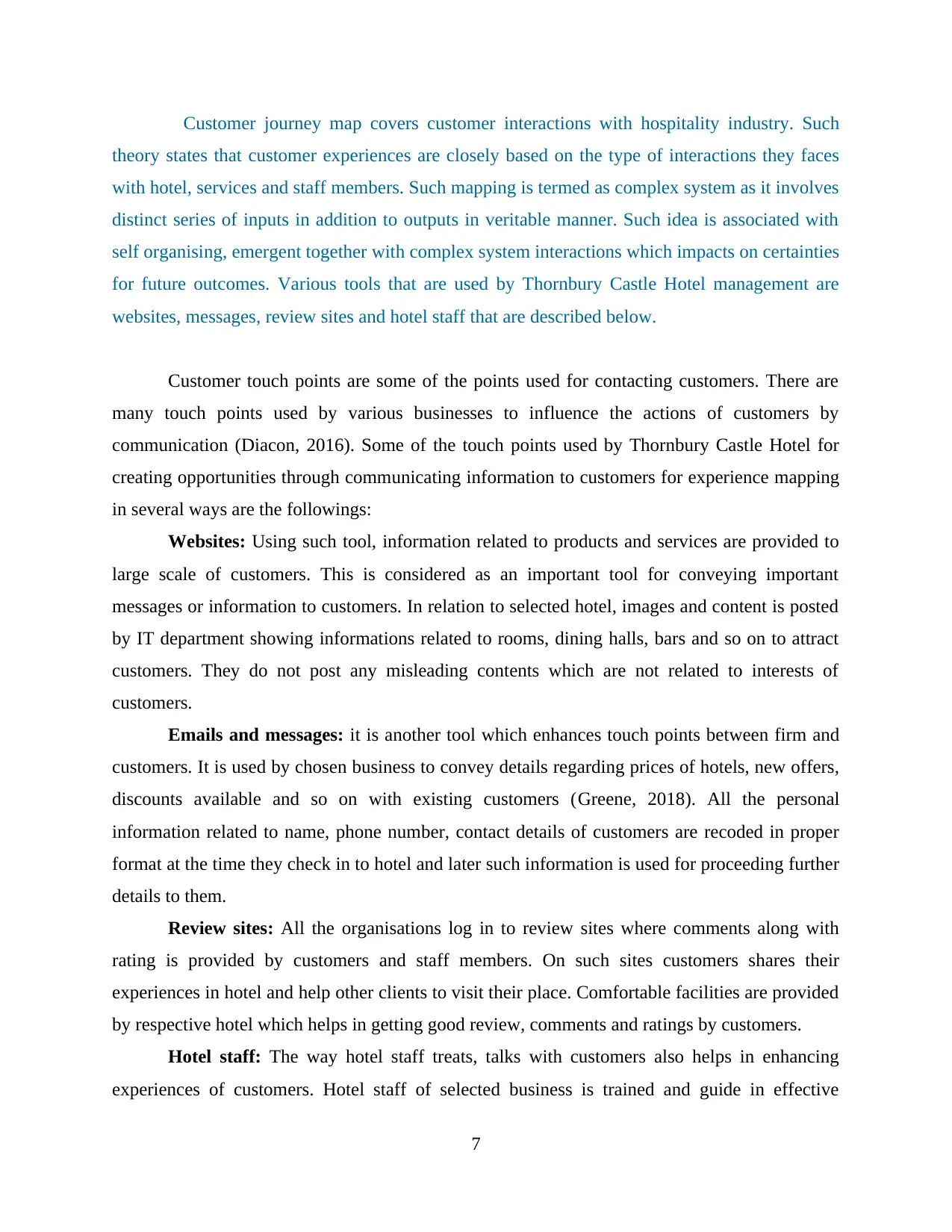
Customer journey map covers customer interactions with hospitality industry. Such
theory states that customer experiences are closely based on the type of interactions they faces
with hotel, services and staff members. Such mapping is termed as complex system as it involves
distinct series of inputs in addition to outputs in veritable manner. Such idea is associated with
self organising, emergent together with complex system interactions which impacts on certainties
for future outcomes. Various tools that are used by Thornbury Castle Hotel management are
websites, messages, review sites and hotel staff that are described below.
Customer touch points are some of the points used for contacting customers. There are
many touch points used by various businesses to influence the actions of customers by
communication (Diacon, 2016). Some of the touch points used by Thornbury Castle Hotel for
creating opportunities through communicating information to customers for experience mapping
in several ways are the followings:
Websites: Using such tool, information related to products and services are provided to
large scale of customers. This is considered as an important tool for conveying important
messages or information to customers. In relation to selected hotel, images and content is posted
by IT department showing informations related to rooms, dining halls, bars and so on to attract
customers. They do not post any misleading contents which are not related to interests of
customers.
Emails and messages: it is another tool which enhances touch points between firm and
customers. It is used by chosen business to convey details regarding prices of hotels, new offers,
discounts available and so on with existing customers (Greene, 2018). All the personal
information related to name, phone number, contact details of customers are recoded in proper
format at the time they check in to hotel and later such information is used for proceeding further
details to them.
Review sites: All the organisations log in to review sites where comments along with
rating is provided by customers and staff members. On such sites customers shares their
experiences in hotel and help other clients to visit their place. Comfortable facilities are provided
by respective hotel which helps in getting good review, comments and ratings by customers.
Hotel staff: The way hotel staff treats, talks with customers also helps in enhancing
experiences of customers. Hotel staff of selected business is trained and guide in effective
7
theory states that customer experiences are closely based on the type of interactions they faces
with hotel, services and staff members. Such mapping is termed as complex system as it involves
distinct series of inputs in addition to outputs in veritable manner. Such idea is associated with
self organising, emergent together with complex system interactions which impacts on certainties
for future outcomes. Various tools that are used by Thornbury Castle Hotel management are
websites, messages, review sites and hotel staff that are described below.
Customer touch points are some of the points used for contacting customers. There are
many touch points used by various businesses to influence the actions of customers by
communication (Diacon, 2016). Some of the touch points used by Thornbury Castle Hotel for
creating opportunities through communicating information to customers for experience mapping
in several ways are the followings:
Websites: Using such tool, information related to products and services are provided to
large scale of customers. This is considered as an important tool for conveying important
messages or information to customers. In relation to selected hotel, images and content is posted
by IT department showing informations related to rooms, dining halls, bars and so on to attract
customers. They do not post any misleading contents which are not related to interests of
customers.
Emails and messages: it is another tool which enhances touch points between firm and
customers. It is used by chosen business to convey details regarding prices of hotels, new offers,
discounts available and so on with existing customers (Greene, 2018). All the personal
information related to name, phone number, contact details of customers are recoded in proper
format at the time they check in to hotel and later such information is used for proceeding further
details to them.
Review sites: All the organisations log in to review sites where comments along with
rating is provided by customers and staff members. On such sites customers shares their
experiences in hotel and help other clients to visit their place. Comfortable facilities are provided
by respective hotel which helps in getting good review, comments and ratings by customers.
Hotel staff: The way hotel staff treats, talks with customers also helps in enhancing
experiences of customers. Hotel staff of selected business is trained and guide in effective
7
Paraphrase This Document
Need a fresh take? Get an instant paraphrase of this document with our AI Paraphraser
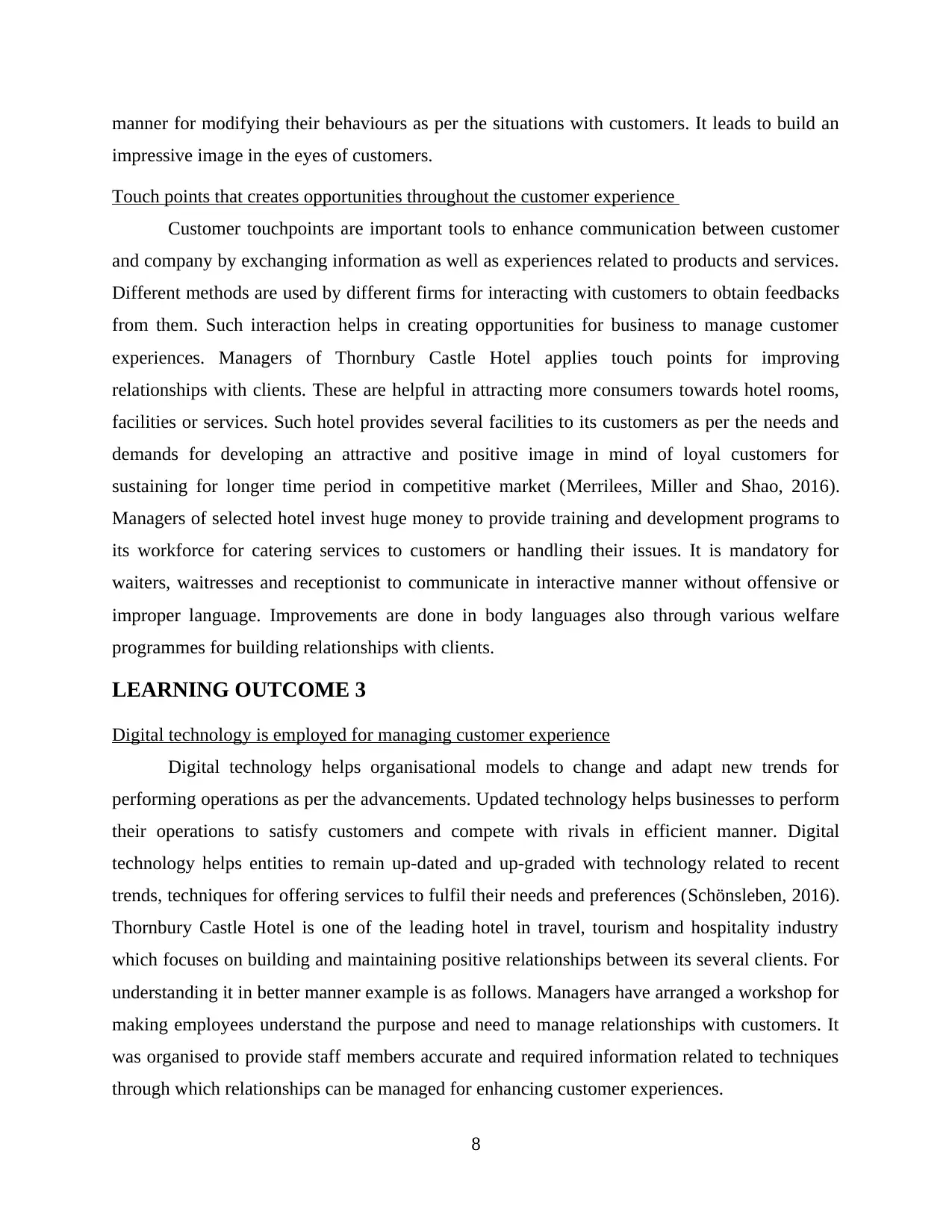
manner for modifying their behaviours as per the situations with customers. It leads to build an
impressive image in the eyes of customers.
Touch points that creates opportunities throughout the customer experience
Customer touchpoints are important tools to enhance communication between customer
and company by exchanging information as well as experiences related to products and services.
Different methods are used by different firms for interacting with customers to obtain feedbacks
from them. Such interaction helps in creating opportunities for business to manage customer
experiences. Managers of Thornbury Castle Hotel applies touch points for improving
relationships with clients. These are helpful in attracting more consumers towards hotel rooms,
facilities or services. Such hotel provides several facilities to its customers as per the needs and
demands for developing an attractive and positive image in mind of loyal customers for
sustaining for longer time period in competitive market (Merrilees, Miller and Shao, 2016).
Managers of selected hotel invest huge money to provide training and development programs to
its workforce for catering services to customers or handling their issues. It is mandatory for
waiters, waitresses and receptionist to communicate in interactive manner without offensive or
improper language. Improvements are done in body languages also through various welfare
programmes for building relationships with clients.
LEARNING OUTCOME 3
Digital technology is employed for managing customer experience
Digital technology helps organisational models to change and adapt new trends for
performing operations as per the advancements. Updated technology helps businesses to perform
their operations to satisfy customers and compete with rivals in efficient manner. Digital
technology helps entities to remain up-dated and up-graded with technology related to recent
trends, techniques for offering services to fulfil their needs and preferences (Schönsleben, 2016).
Thornbury Castle Hotel is one of the leading hotel in travel, tourism and hospitality industry
which focuses on building and maintaining positive relationships between its several clients. For
understanding it in better manner example is as follows. Managers have arranged a workshop for
making employees understand the purpose and need to manage relationships with customers. It
was organised to provide staff members accurate and required information related to techniques
through which relationships can be managed for enhancing customer experiences.
8
impressive image in the eyes of customers.
Touch points that creates opportunities throughout the customer experience
Customer touchpoints are important tools to enhance communication between customer
and company by exchanging information as well as experiences related to products and services.
Different methods are used by different firms for interacting with customers to obtain feedbacks
from them. Such interaction helps in creating opportunities for business to manage customer
experiences. Managers of Thornbury Castle Hotel applies touch points for improving
relationships with clients. These are helpful in attracting more consumers towards hotel rooms,
facilities or services. Such hotel provides several facilities to its customers as per the needs and
demands for developing an attractive and positive image in mind of loyal customers for
sustaining for longer time period in competitive market (Merrilees, Miller and Shao, 2016).
Managers of selected hotel invest huge money to provide training and development programs to
its workforce for catering services to customers or handling their issues. It is mandatory for
waiters, waitresses and receptionist to communicate in interactive manner without offensive or
improper language. Improvements are done in body languages also through various welfare
programmes for building relationships with clients.
LEARNING OUTCOME 3
Digital technology is employed for managing customer experience
Digital technology helps organisational models to change and adapt new trends for
performing operations as per the advancements. Updated technology helps businesses to perform
their operations to satisfy customers and compete with rivals in efficient manner. Digital
technology helps entities to remain up-dated and up-graded with technology related to recent
trends, techniques for offering services to fulfil their needs and preferences (Schönsleben, 2016).
Thornbury Castle Hotel is one of the leading hotel in travel, tourism and hospitality industry
which focuses on building and maintaining positive relationships between its several clients. For
understanding it in better manner example is as follows. Managers have arranged a workshop for
making employees understand the purpose and need to manage relationships with customers. It
was organised to provide staff members accurate and required information related to techniques
through which relationships can be managed for enhancing customer experiences.
8
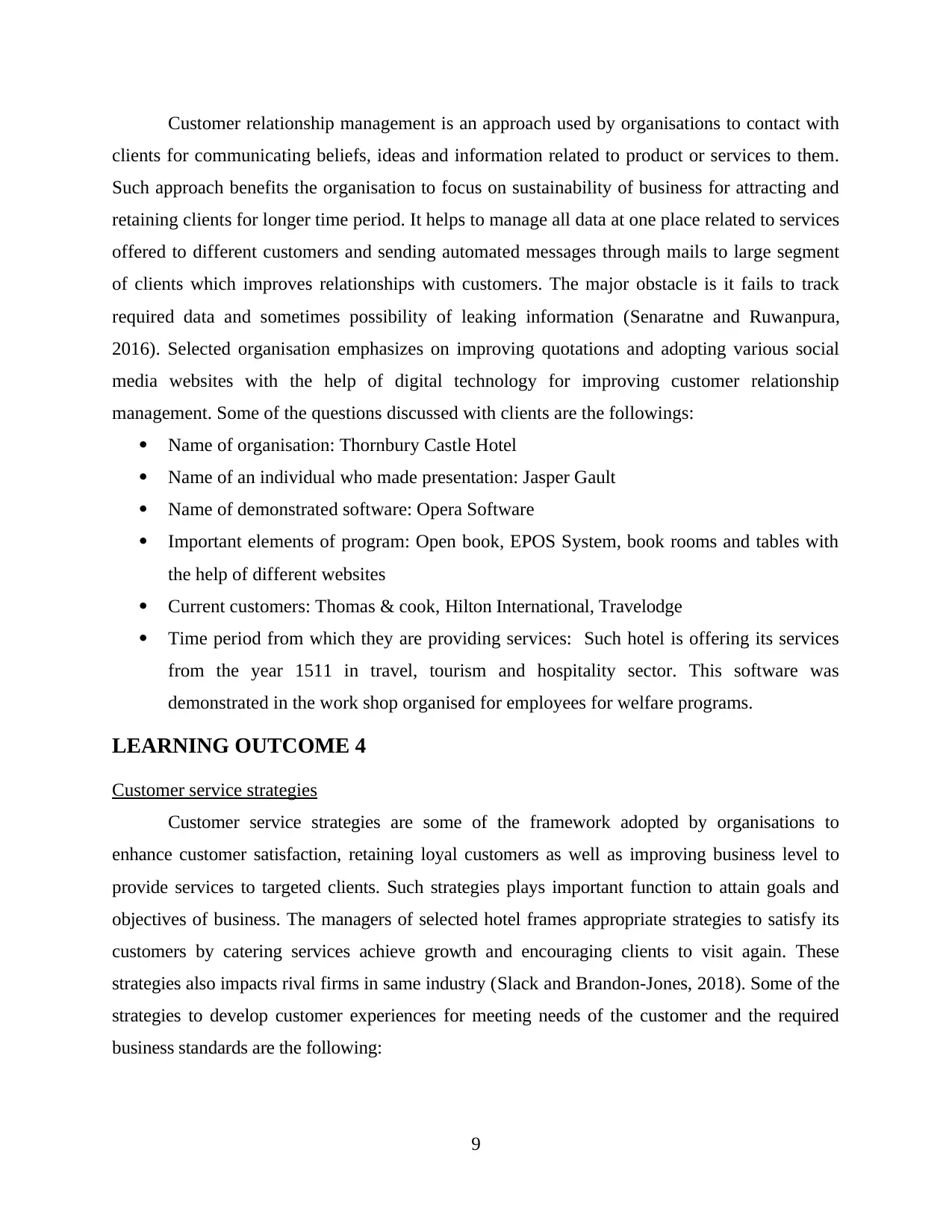
Customer relationship management is an approach used by organisations to contact with
clients for communicating beliefs, ideas and information related to product or services to them.
Such approach benefits the organisation to focus on sustainability of business for attracting and
retaining clients for longer time period. It helps to manage all data at one place related to services
offered to different customers and sending automated messages through mails to large segment
of clients which improves relationships with customers. The major obstacle is it fails to track
required data and sometimes possibility of leaking information (Senaratne and Ruwanpura,
2016). Selected organisation emphasizes on improving quotations and adopting various social
media websites with the help of digital technology for improving customer relationship
management. Some of the questions discussed with clients are the followings:
Name of organisation: Thornbury Castle Hotel
Name of an individual who made presentation: Jasper Gault
Name of demonstrated software: Opera Software
Important elements of program: Open book, EPOS System, book rooms and tables with
the help of different websites
Current customers: Thomas & cook, Hilton International, Travelodge
Time period from which they are providing services: Such hotel is offering its services
from the year 1511 in travel, tourism and hospitality sector. This software was
demonstrated in the work shop organised for employees for welfare programs.
LEARNING OUTCOME 4
Customer service strategies
Customer service strategies are some of the framework adopted by organisations to
enhance customer satisfaction, retaining loyal customers as well as improving business level to
provide services to targeted clients. Such strategies plays important function to attain goals and
objectives of business. The managers of selected hotel frames appropriate strategies to satisfy its
customers by catering services achieve growth and encouraging clients to visit again. These
strategies also impacts rival firms in same industry (Slack and Brandon-Jones, 2018). Some of the
strategies to develop customer experiences for meeting needs of the customer and the required
business standards are the following:
9
clients for communicating beliefs, ideas and information related to product or services to them.
Such approach benefits the organisation to focus on sustainability of business for attracting and
retaining clients for longer time period. It helps to manage all data at one place related to services
offered to different customers and sending automated messages through mails to large segment
of clients which improves relationships with customers. The major obstacle is it fails to track
required data and sometimes possibility of leaking information (Senaratne and Ruwanpura,
2016). Selected organisation emphasizes on improving quotations and adopting various social
media websites with the help of digital technology for improving customer relationship
management. Some of the questions discussed with clients are the followings:
Name of organisation: Thornbury Castle Hotel
Name of an individual who made presentation: Jasper Gault
Name of demonstrated software: Opera Software
Important elements of program: Open book, EPOS System, book rooms and tables with
the help of different websites
Current customers: Thomas & cook, Hilton International, Travelodge
Time period from which they are providing services: Such hotel is offering its services
from the year 1511 in travel, tourism and hospitality sector. This software was
demonstrated in the work shop organised for employees for welfare programs.
LEARNING OUTCOME 4
Customer service strategies
Customer service strategies are some of the framework adopted by organisations to
enhance customer satisfaction, retaining loyal customers as well as improving business level to
provide services to targeted clients. Such strategies plays important function to attain goals and
objectives of business. The managers of selected hotel frames appropriate strategies to satisfy its
customers by catering services achieve growth and encouraging clients to visit again. These
strategies also impacts rival firms in same industry (Slack and Brandon-Jones, 2018). Some of the
strategies to develop customer experiences for meeting needs of the customer and the required
business standards are the following:
9
⊘ This is a preview!⊘
Do you want full access?
Subscribe today to unlock all pages.

Trusted by 1+ million students worldwide
1 out of 15
Related Documents
Your All-in-One AI-Powered Toolkit for Academic Success.
+13062052269
info@desklib.com
Available 24*7 on WhatsApp / Email
![[object Object]](/_next/static/media/star-bottom.7253800d.svg)
Unlock your academic potential
Copyright © 2020–2025 A2Z Services. All Rights Reserved. Developed and managed by ZUCOL.




